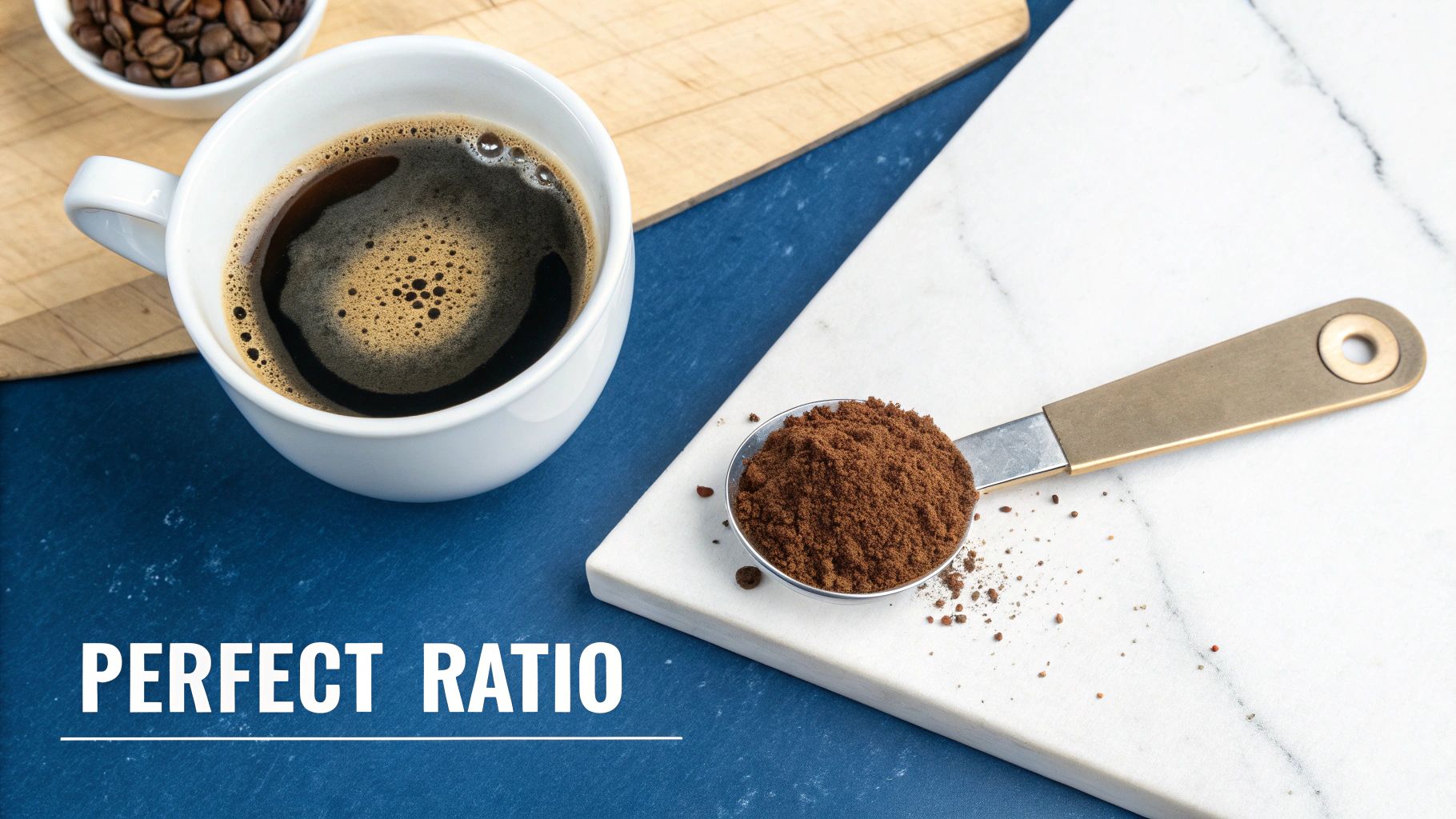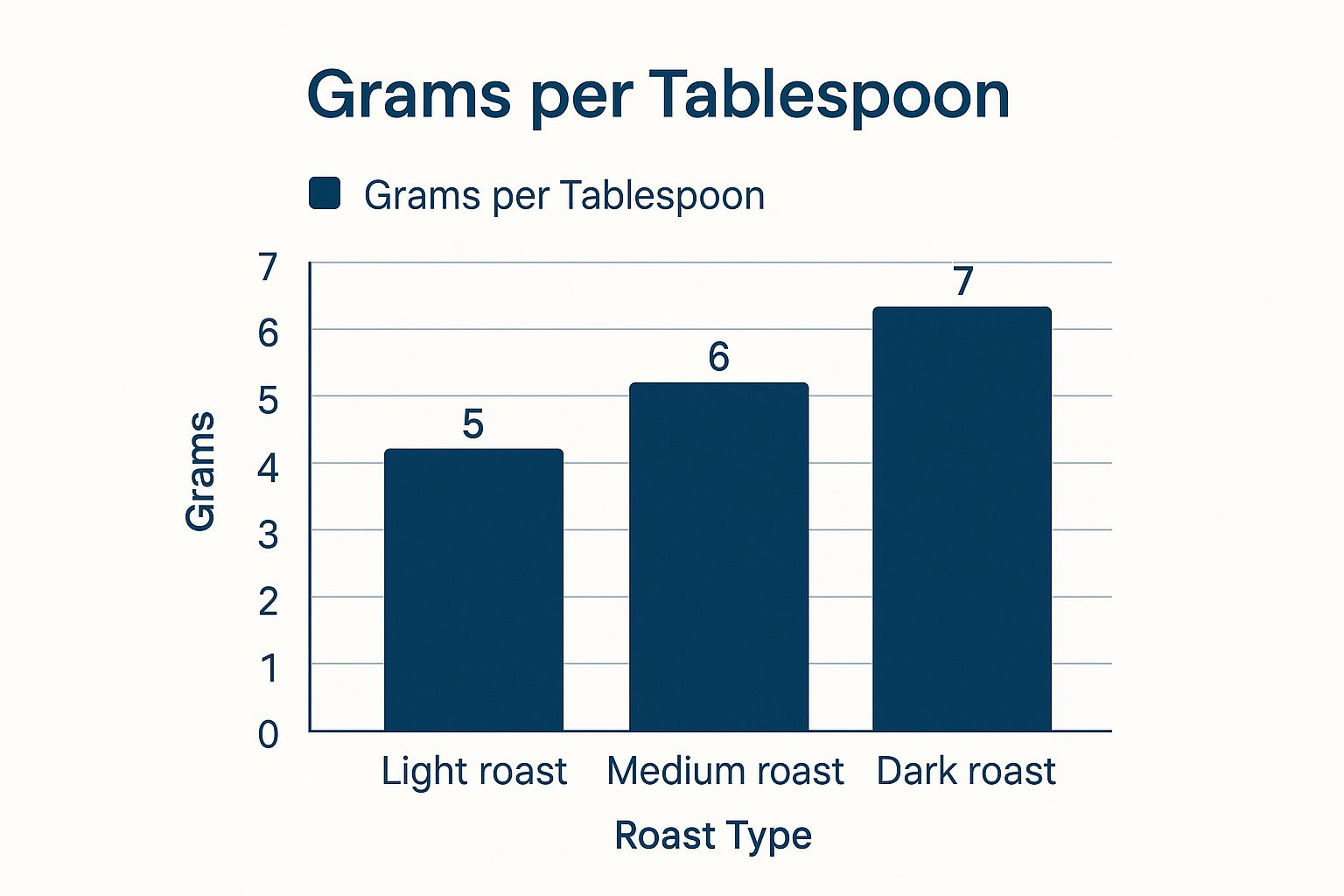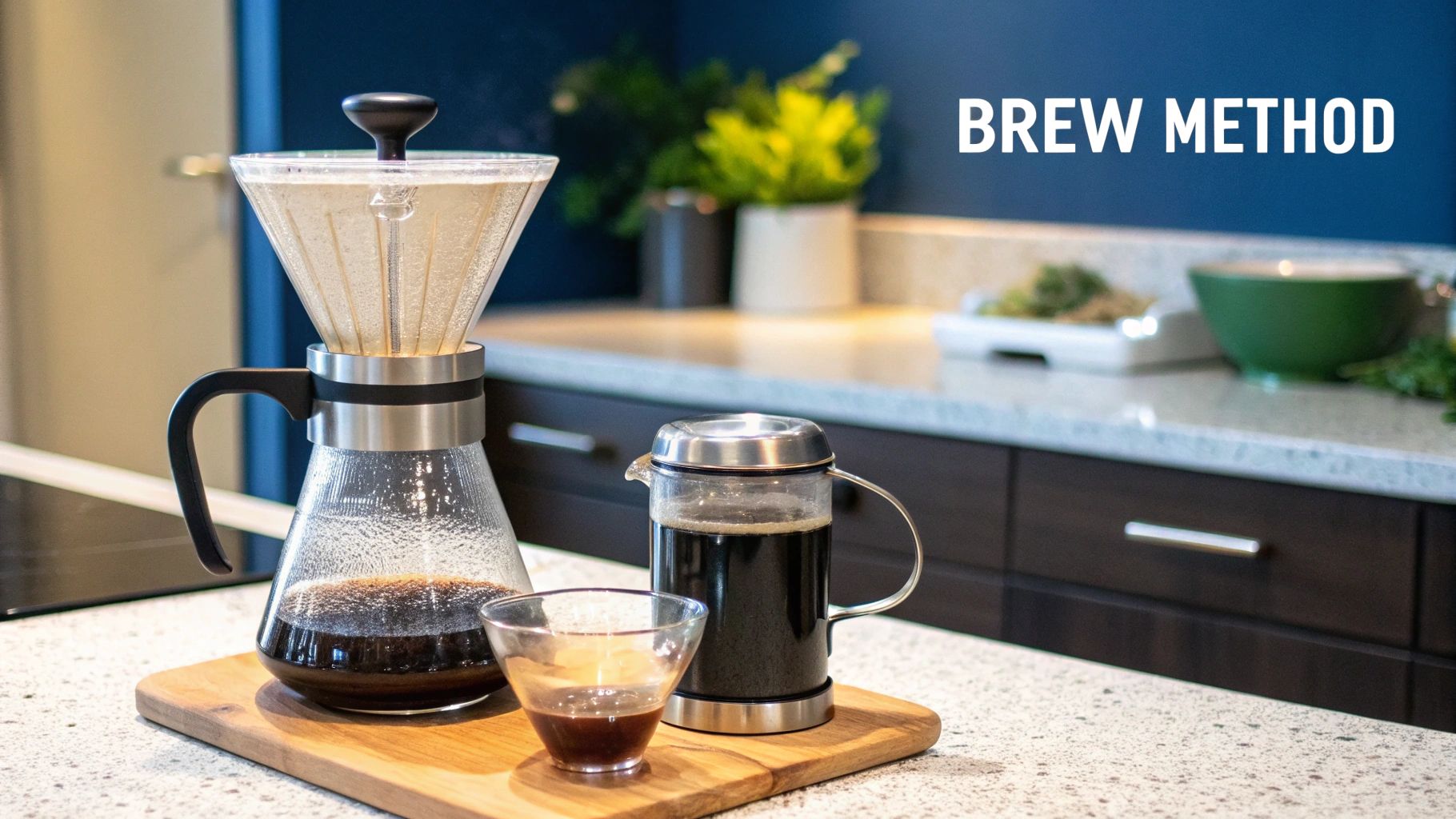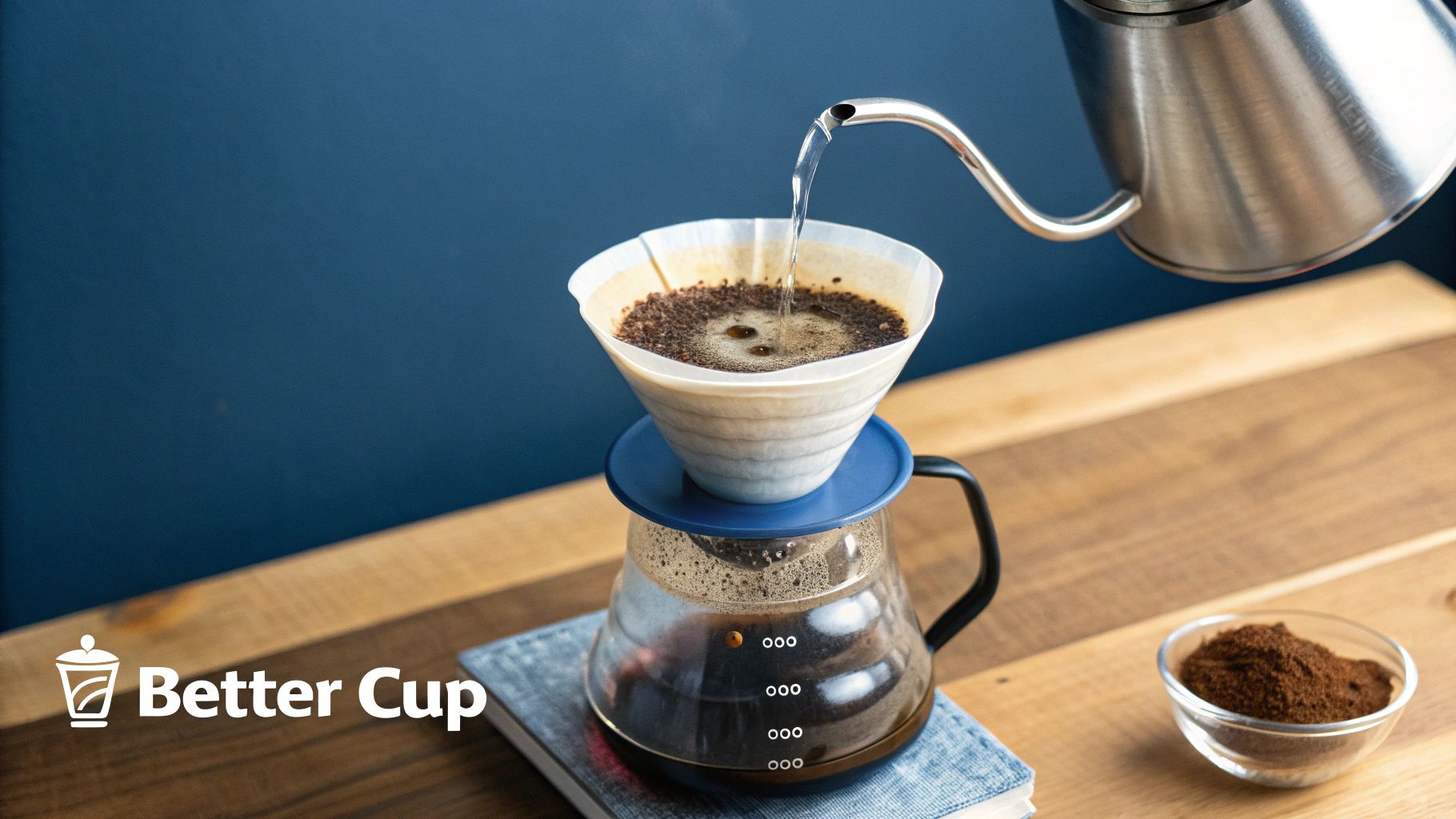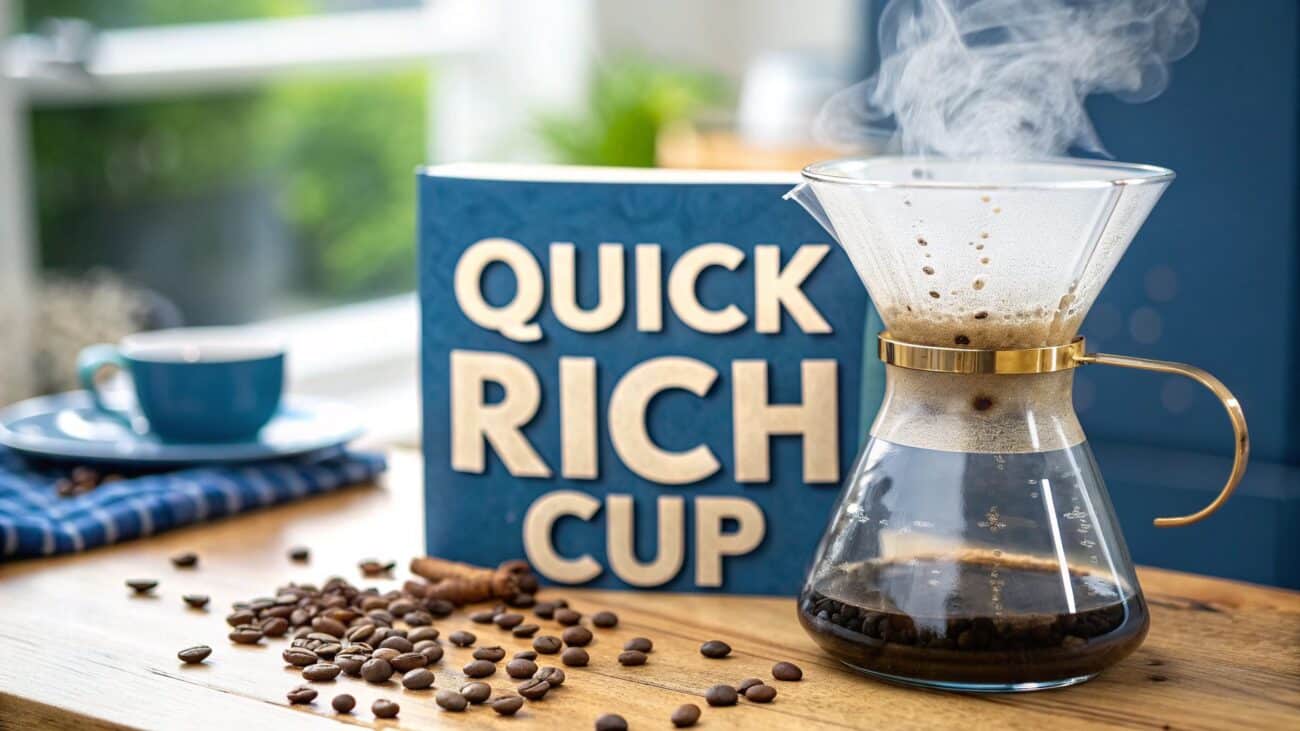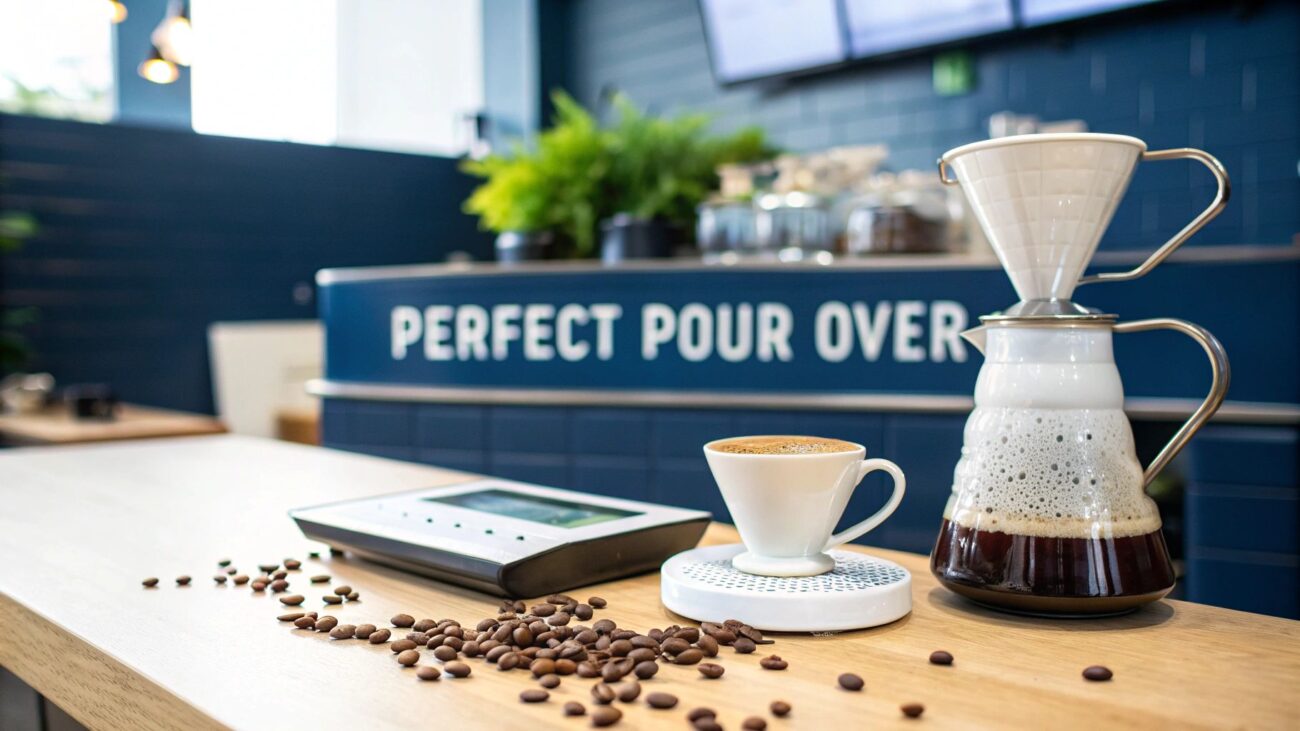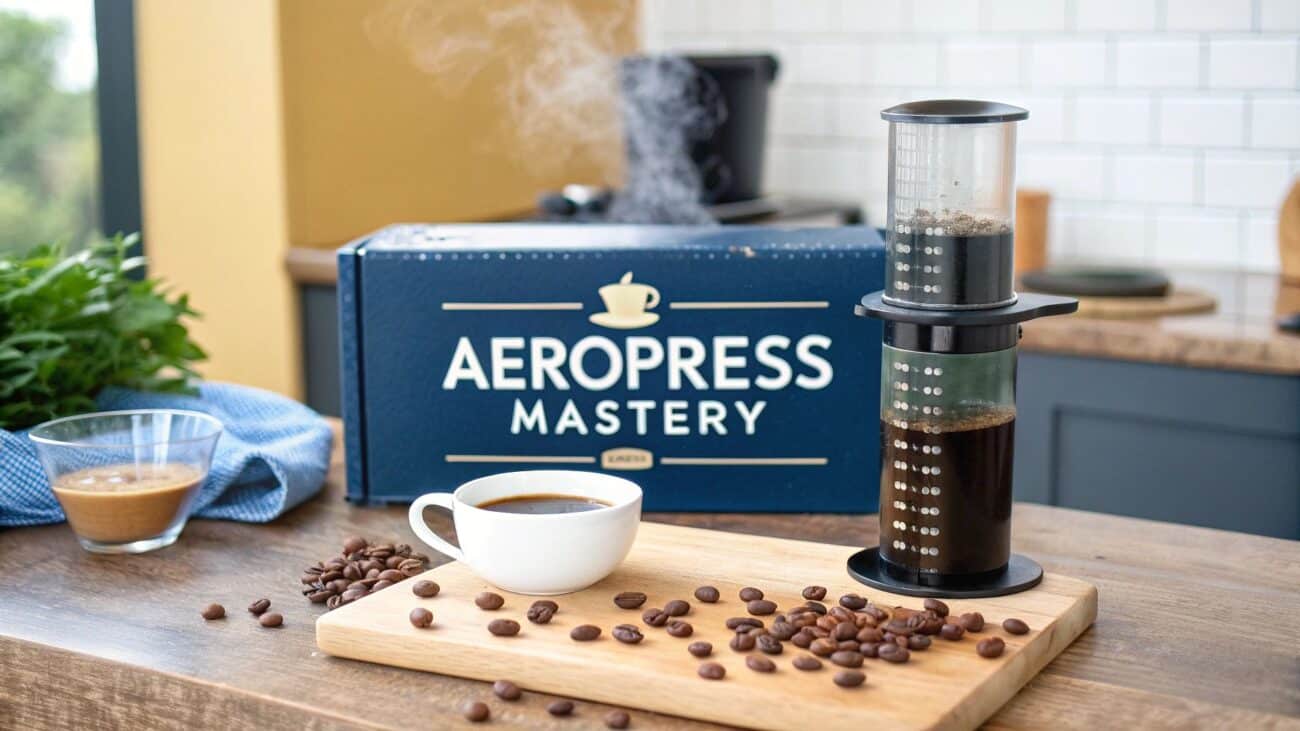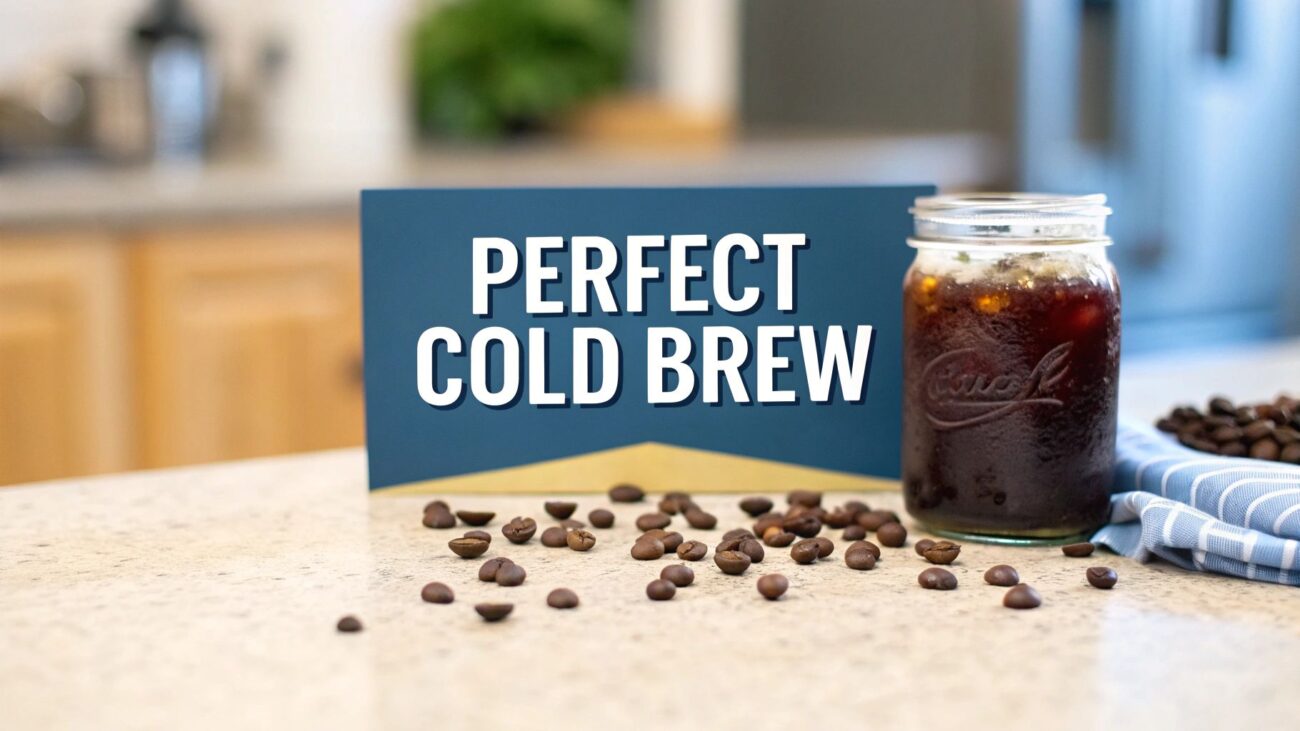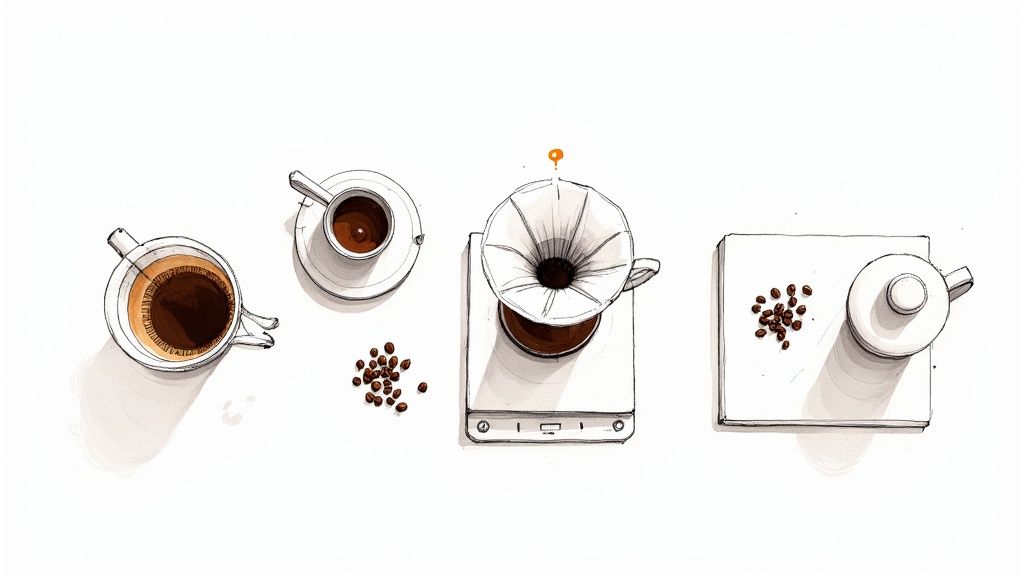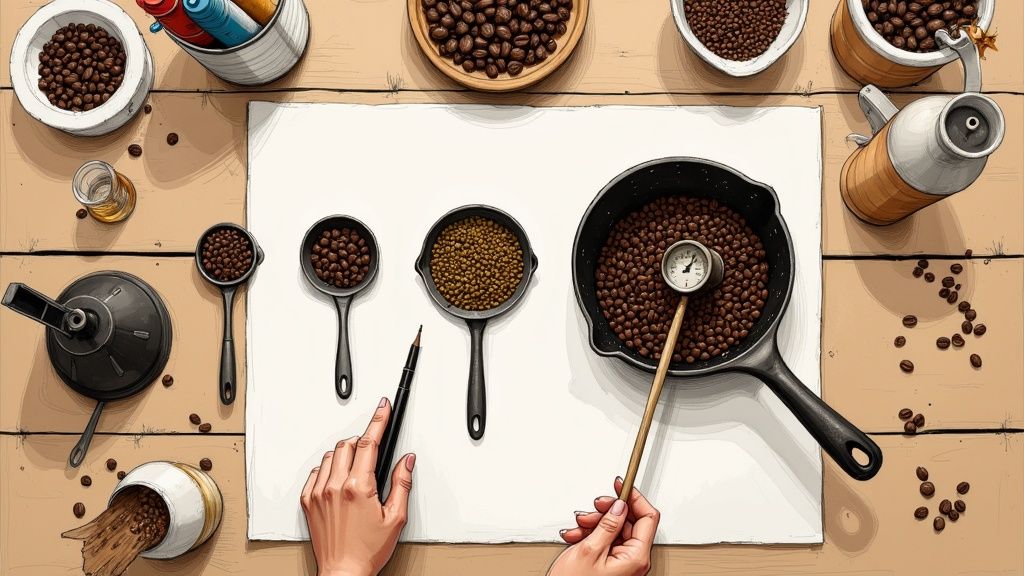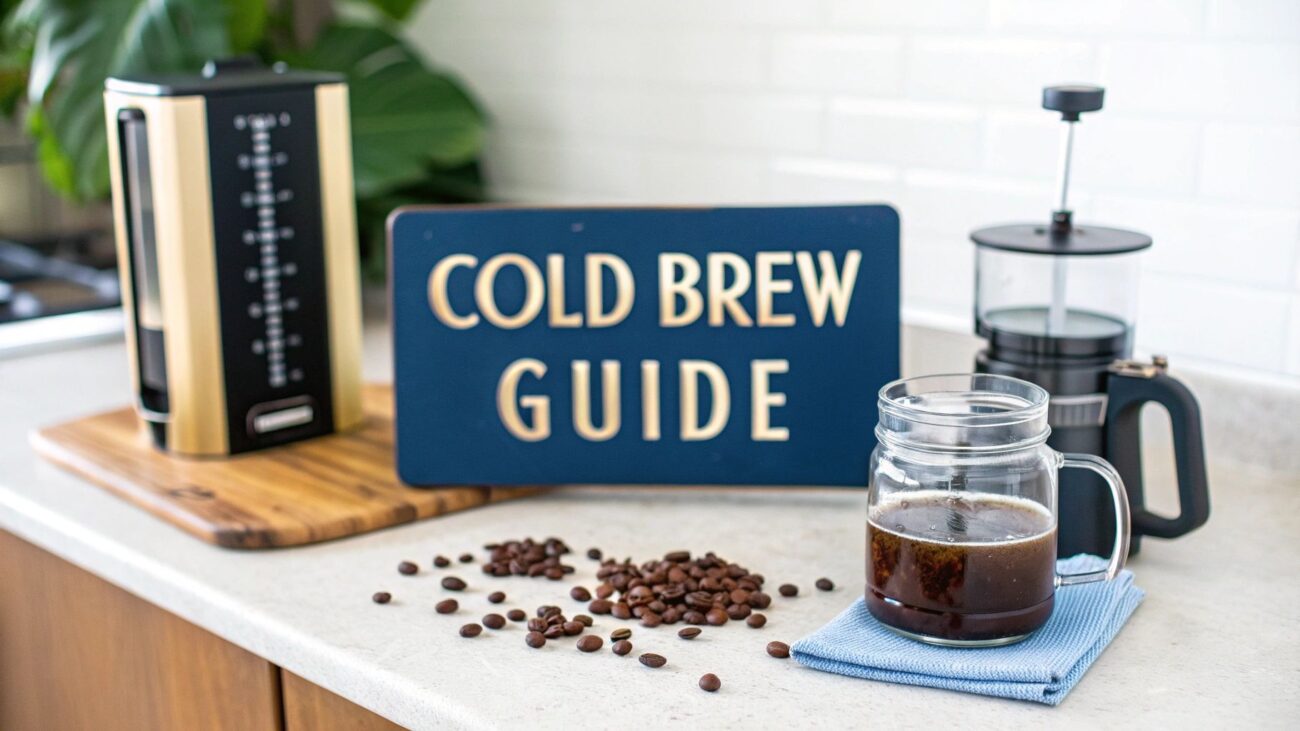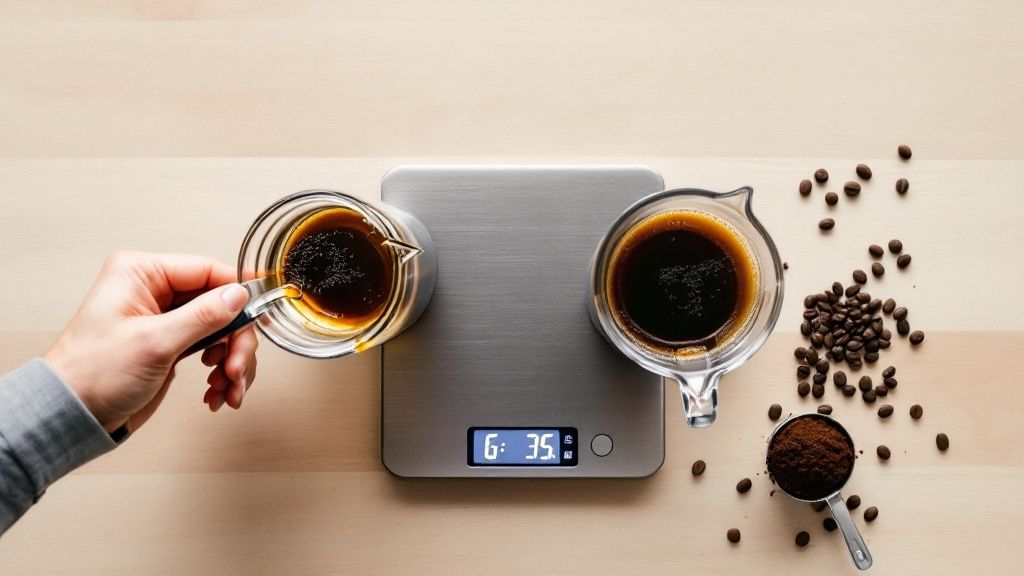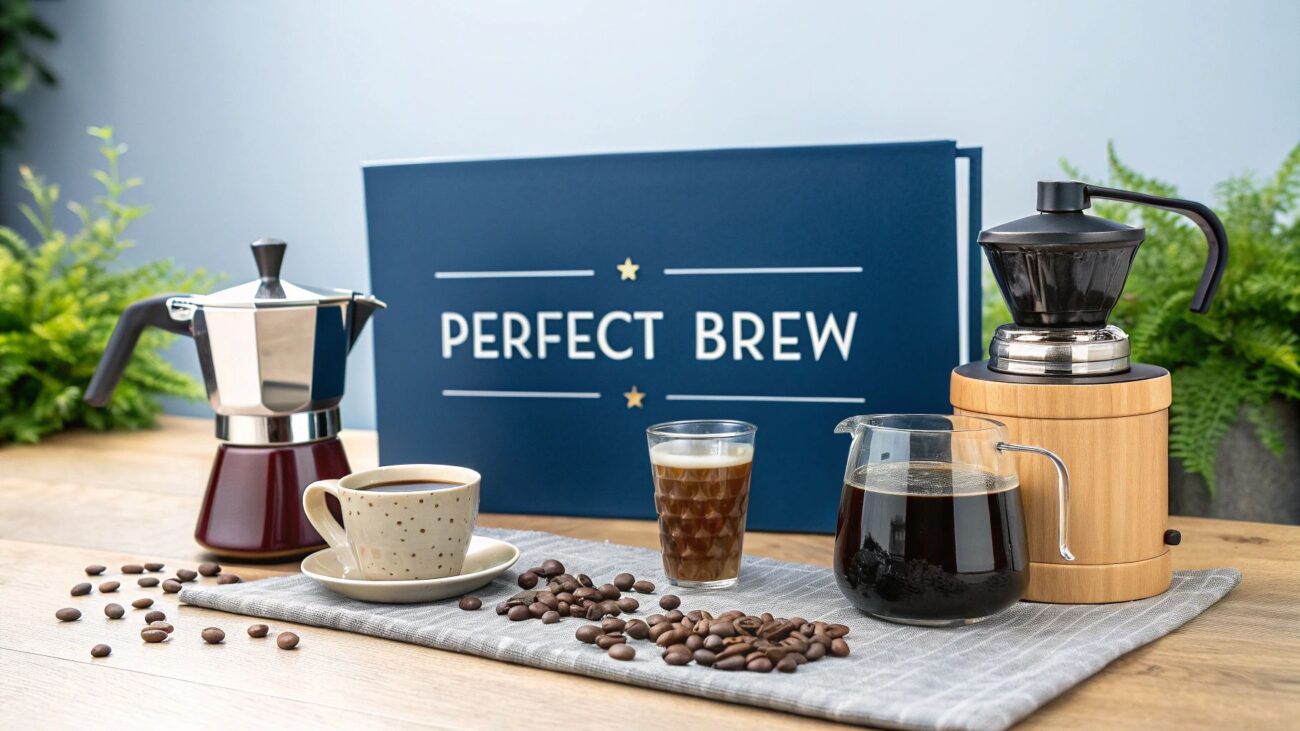How Many Tablespoons Per Cup of Coffee? Your Essential Guide
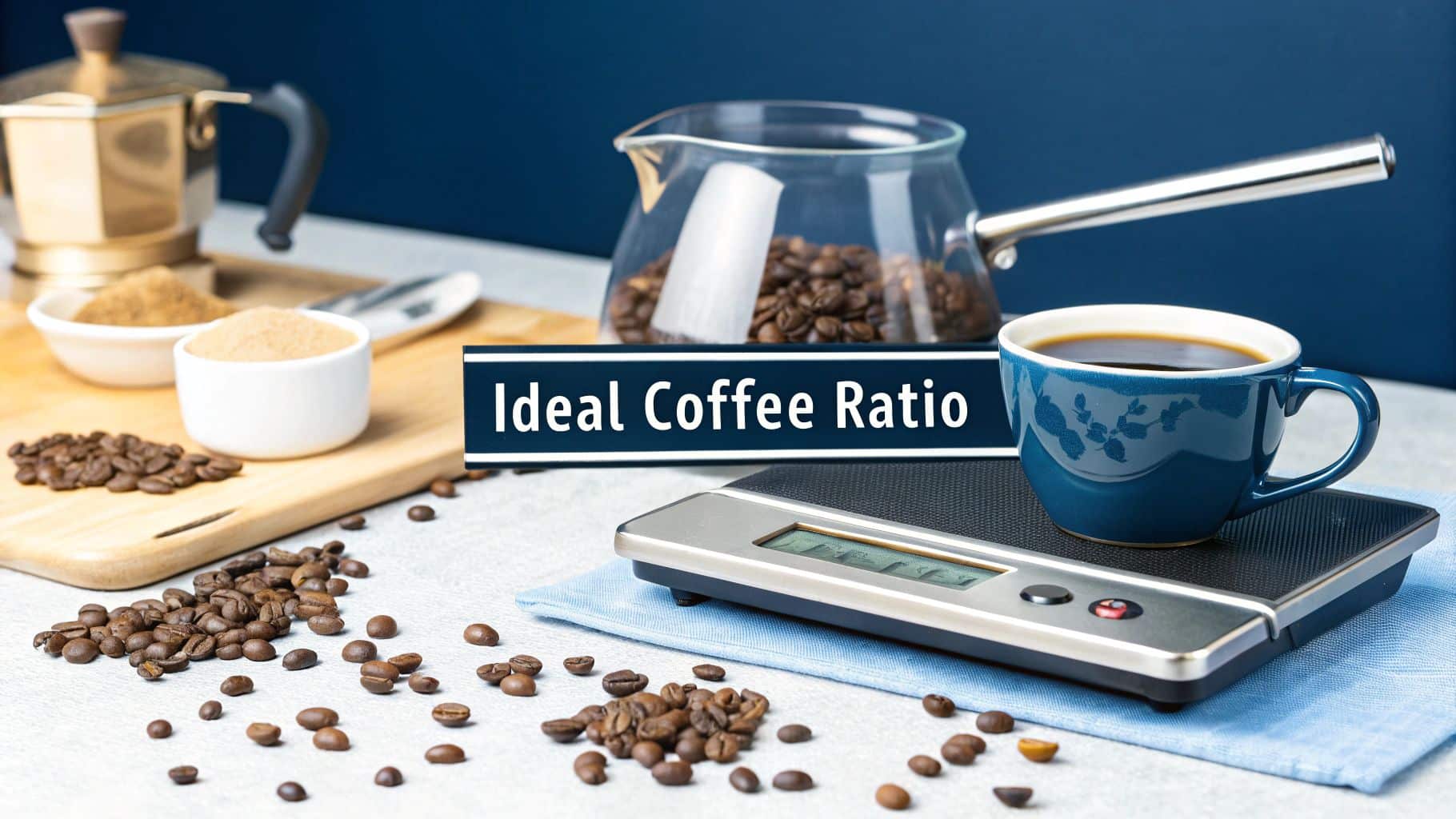
For a brilliant cup of coffee, the golden rule you’ll often hear is one to two tablespoons of ground coffee for every 240ml of water. It’s a solid starting point, for sure. But the truth is, the perfect amount is less about a rigid formula and more about your personal taste, the specific beans you’re using, and how you’re brewing it.
Getting Your Coffee Ratio Just Right
Figuring out how many tablespoons of coffee to use per cup can feel a bit like guesswork, but it doesn't have to be complicated. That one-to-two-tablespoon ratio is a great foundation for nearly any brew you can think of. Think of it as a reliable guideline, not a strict command.
Ultimately, your own palate is the final judge. Do you crave a bold, punchy flavour that really wakes you up, or do you prefer something a bit smoother and milder? A great way to find out is to start with two tablespoons and simply adjust your next brew from there.
What Changes the Magic Number?
A few key things can tweak that ideal measurement for your perfect cup.
- The Beans Themselves: Dense, light-roast beans take up less space than their oily, dark-roast counterparts. That means a tablespoon of each will have a different weight, and therefore, a different impact on your brew.
- Your Brewing Method: A cafetière, for instance, often sings with a slightly stronger ratio to get that full-bodied, robust taste. On the other hand, a pour-over is all about precision, so getting the measurement spot-on makes a huge difference. You can dive deeper into different approaches in our guide to https://sevensisterscoffee.co.uk/brew-coffee/.
- Your Personal Taste: This is the big one. The best ratio is the one that makes you happy. Don't ever be afraid to experiment and find what works for you.
For a quick reference, here’s a simple table to get you started based on your preferred strength.
Quick Guide to Coffee Strength
This table is a great starting point for finding your ideal ratio using a standard 240ml cup.
| Desired Strength | Tablespoons of Coffee | Approximate Grams |
|---|---|---|
| Milder | 1 level tablespoon | 7-8 grams |
| Standard | 2 level tablespoons | 15 grams |
| Stronger | 2 heaped tablespoons | 18-20 grams |
Remember to use this as a guide and adjust based on your results. The perfect cup is a personal journey!
A good rule of thumb is to start with a 1:16 ratio—that's one part coffee to 16 parts water. For a 240ml cup, this works out to be roughly 15 grams of coffee, or about two level tablespoons.
Why Weighing Your Beans Is a Game Changer
Relying on a tablespoon for your daily brew is certainly convenient, but it's often the single biggest barrier to a consistently brilliant cup of coffee. Let's be honest, measuring coffee by volume is notoriously unreliable. Why? Because not all coffee beans are created equal; their density can vary massively.
A scoop of light, fluffy Ethiopian beans, for instance, will weigh far less than the same scoop of dense, oily beans from Sumatra. This means even if you use the exact same number of tablespoons, you're using a different amount of actual coffee grounds each time. This is why one day your coffee tastes perfect, and the next it just falls flat.
Precision Creates Repeatability
Grind size throws another spanner in the works. Coarsely ground coffee, the kind you’d use for a cafetière, has more air pockets between the particles. This means less coffee actually fits into your spoon compared to the same volume of finely ground beans needed for an espresso.
This simple infographic really drives the point home, showing how much the weight of one tablespoon can differ just based on the roast level.
As you can see, a tablespoon of dark roast can weigh up to 40% more than the same scoop of a light roast. That's a huge difference that will drastically alter the strength and flavour of your brew.
This is precisely why a simple digital scale is the most valuable tool for any coffee lover. By weighing your beans, you take control of the most important variable in your recipe. It's the secret to unlocking repeatable, café-quality results in your own kitchen, every single morning.
By measuring with a scale, you move from guesswork to precision. A 15-gram dose of coffee will always be 15 grams, regardless of the bean's origin, roast level, or grind size. This guarantees a consistent foundation for your brew every time.
Ultimately, weighing your coffee isn't about being overly technical; it's about empowerment. It gives you the ability to replicate that perfect cup you made last Tuesday and to make tiny, informed adjustments to fine-tune your next one. Consistency also helps you better understand your beans, ensuring you get the most flavour out of them—especially after you've learned how to store coffee beans correctly to keep them fresh.
Adapting Ratios for Your Brewing Method
Your coffee maker really dictates the rules of the game here. The way each one extracts flavour is completely different, so a single, one-size-fits-all ratio just isn't going to get you the best results across the board. The real secret is to tailor your approach to your brewer’s unique strengths.
Take the classic cafetière, for instance. It uses full immersion brewing, where the grounds hang out in the water for a few minutes. To get that rich, full-bodied flavour without it turning bitter or sludgy, you'll generally want a slightly stronger ratio and a coarser grind.
On the other hand, a pour-over gives you total control over every little detail. This precision works brilliantly with a more standard coffee-to-water ratio, which is perfect for letting all the subtle, delicate notes of the beans really sing.
Starting Points for Popular Brewers
To help you get started, here are a few reliable jumping-off points for the most common brewers we see in the UK. Think of these as a solid baseline—from here, you can tweak and experiment until it's just right for your palate.
Starting Ratios for Popular Brewers
| Brewing Method | Coffee to Water Ratio | Tablespoons per 240ml | Recommended Grind |
|---|---|---|---|
| Cafetière | 1:15 (Stronger) | 2 heaped tablespoons | Coarse |
| Pour-Over | 1:16 (Standard) | 2 level tablespoons | Medium-Fine |
| AeroPress | 1:14 (Concentrated) | 2.5 level tablespoons | Fine |
| Moka Pot | Varies | Fill basket loosely | Fine |
These ratios aren't just pulled out of thin air; they're a good reflection of what you'll find across the UK coffee scene. Most speciality roasters and cafes recommend about 2 tablespoons (around 15–18g) of ground coffee for every 240ml of water as a fantastic starting point for any manual brew method. It’s the sweet spot for a strong, flavourful cup.
A Closer Look at Specific Methods
For a cafetière, that slightly coarser grind and longer brew time mean you need a bit more coffee to get a balanced extraction. Kicking off with a 1:15 ratio—or those two heaped tablespoons—helps prevent the final brew from tasting weak or watery.
The pour-over is all about precision and control. A 1:16 ratio paired with a medium-fine grind is your best bet for pulling out all those bright, complex notes from the beans. If you really want to get the most from this method, perfecting your pour is key, and our guide on V60 coffee brewing is a great place to start.
The AeroPress is the chameleon of the coffee world—it's incredibly versatile. A popular technique is to brew a strong concentrate using a tight ratio like 1:14, then simply top it up with hot water until you hit the strength you love.
The Moka pot is the odd one out here, as it doesn't really follow the standard ratio rules. Instead of weighing or measuring with spoons, the best approach is to just fill the filter basket with coffee grounds until it's level. Whatever you do, don't tamp it down! This ensures water flows through properly and you don’t build up too much pressure.
How to Dial In Your Perfect Brew
Finding your ideal coffee strength is a deeply personal journey, not some rigid formula you have to follow. While starting with a good ratio is helpful, the real magic happens when you learn how to ‘dial in’ your brew. It’s all about tasting your coffee critically and making small, informed adjustments.
Think of it like seasoning a dish while you cook—you taste as you go. The key is connecting what you taste in the cup to a specific, actionable fix. This is how you move from just following recipes to truly crafting your perfect cup, every single time, no matter what beans you're using.
A Simple Troubleshooting Framework
Let's break down the most common taste issues and what they're telling you about your brew. Once you understand these signals, you can fine-tune your process like a pro.
-
If your coffee tastes sour, thin, or just a bit empty: This is a classic sign of under-extraction. The water just hasn't had enough time or opportunity to pull out all the sweet, complex flavours from the grounds.
- The Fix: Try adding a little more coffee to your next brew. Alternatively, you can use a slightly finer grind. Both of these changes increase the surface area and slow down the water flow, helping to extract more of the good stuff.
-
If your coffee tastes harsh, bitter, or muddy: This usually points to over-extraction. The water has pulled way too much from the coffee, including those unpleasant, bitter compounds you want to leave behind.
- The Fix: Use slightly less coffee next time, or opt for a coarser grind. This will let the water pass through more freely, reducing the extraction and resulting in a much smoother, more balanced flavour.
Learning to pinpoint these characteristics is a skill, and adjusting your grind size is often the most powerful tool you have to fix them. For a more detailed look, you can explore our complete coffee grind size guide to really master this crucial variable.
Here's the key takeaway: Sourness often means you need to extract more, while bitterness means you need to extract less. This simple principle is your most powerful tool for dialling in the perfect brew and getting the absolute most out of every bag of beans. Start with a baseline, then taste and tweak.
Simple Tips for an Even Better Cup
Once you've settled on the perfect number of tablespoons for your taste, a few small details can elevate your daily brew from good to genuinely special. These simple tweaks don’t cost a thing, but they make a world of difference to the final flavour.
Believe it or not, one of the most overlooked elements is your water. Since coffee is over 98% water, its quality has a huge impact. If you're in a hard water area, like many of us are across the UK, using filtered water can remove chlorine and excess minerals that often mask the delicate notes of your beans.
Master Your Water Temperature
Getting your water temperature right is critical for a balanced extraction. You're aiming for a sweet spot just off the boil, ideally between 90-96°C. If the water is scorching hot, it can scald the grounds and leave you with a bitter, harsh taste. Too cool, and you’ll end up with a weak, under-extracted cup that just tastes flat.
Here’s a simple trick I use every day: just let your kettle sit for about 30-60 seconds after it boils before you pour. That small pause is usually all it takes to bring it down into that perfect brewing range.
Before your next brew, try a technique called the 'bloom'. Pour just enough hot water over the fresh grounds to saturate them completely, then wait for about 30 seconds. You’ll see them bubble and expand as trapped CO₂ escapes. This simple step leads to a much more even and flavourful extraction.
This blooming process effectively prepares the coffee bed, ensuring every single particle is ready to release its full potential when you continue your pour.
Finally, once you've perfected your brew, why not enhance the whole experience? Exploring various coffee drinkware options can make your daily ritual even more enjoyable. It’s funny how the right mug really can make a perfect coffee taste even better.
Common Questions About Measuring Coffee
Even with the best guidance, a few questions always seem to pop up when you're dialling in the perfect number of tablespoons for your daily brew. Let's tackle some of the most common ones to get you brewing with complete confidence.
One of the first things people ask is how to scale a recipe up. If two tablespoons are perfect for one cup, what about a full pot? The trick is to keep the ratio consistent. For a larger 1-litre cafetière, which makes about four cups, you’ll want to use eight level tablespoons. This ensures every cup has that same great strength you're aiming for.
What About Different Beans and Scoops?
Another point of confusion is whether the type of bean affects your measurement. And yes, it absolutely does. A tablespoon of a dense, light-roasted bean will actually weigh a bit less than the same scoop filled with a fluffier, oilier dark roast. That difference in weight can definitely tweak the final flavour.
This is exactly why having the right tools makes such a difference. To get that repeatable, delicious cup every single time, investing in a good gold stainless steel measuring cup set can take all the guesswork out of it, no matter which beans you're using.
A "heaped" tablespoon isn't a real unit of measurement and can throw your recipe off by as much as 50% compared to a level one. For a brew you can rely on, always use a level scoop—or better yet, a digital scale.
Getting your measurements spot-on becomes even more critical when you're trying out different brewing methods. For instance, cold brew is famously sensitive to the coffee-to-water balance. If you're keen to explore it, our guide on the perfect cold brew coffee ratio is a great place to start.
At Seven Sisters Coffee Co, we believe the best coffee starts with the best beans. Explore our collection of single-origin and blended coffees to find your perfect match.

